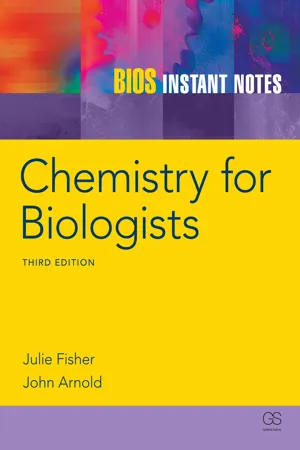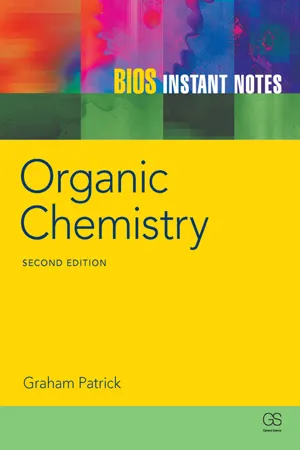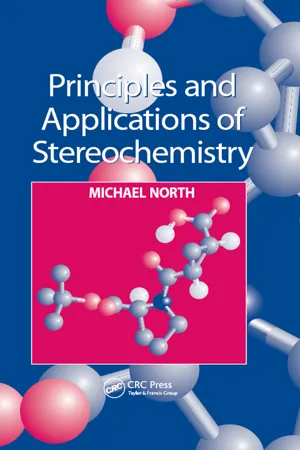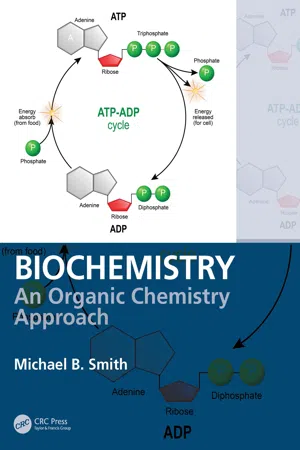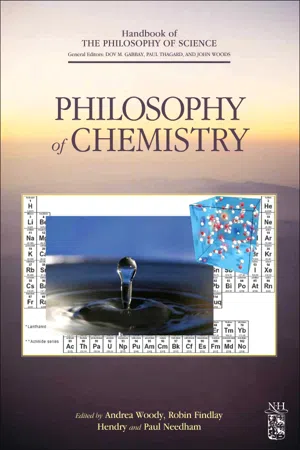Chemistry
Elimination Reaction
An elimination reaction is a chemical reaction in which a molecule loses atoms or functional groups to form a double bond or a ring. It typically involves the removal of two substituents from a molecule, resulting in the formation of a new unsaturated compound. This process often occurs in the presence of a base or acid catalyst.
Written by Perlego with AI-assistance
5 Key excerpts on "Elimination Reaction"
Learn about this page
Index pages curate the most relevant extracts from our library of academic textbooks. They’ve been created using an in-house natural language model (NLM), each adding context and meaning to key research topics.
- eBook - ePub
- J Fisher, J.R.P. Arnold, Julie Fisher, John Arnold(Authors)
- 2020(Publication Date)
- Taylor & Francis(Publisher)
Substitution reactions are those that involve the replacement of part of a molecule (an atom or group of atoms), with an incoming group. In some instances, it is necessary to activate the potential leaving group to make it a better leaving group and thus promote the substitution reaction. Substitution reactions are a feature of carboxylic acid chemistry and aromatic chemistry.Elimination ReactionsElimination Reactions occur with the loss of (generally) a small neutral molecule, from a larger molecule. These reactions are common with alkyl halides and alcohols, leading, in each case, to the formation of alkenes.Oxidation and reduction processesIn organic systems oxidation and reduction reactions are those that involve the gain or loss of oxygen, respectively. Reduction reactions can also involve the gaining of hydrogen; equivalent to the loss of oxygen. In many instances these processes involve free radicals. Oxidation and reduction reactions are features of the chemistry of almost all organic compounds, and are of great significance in biology.Related topics(A1) The periodic table (A2) Electron confgurationAddition reactions
An addition reaction is said to have occurred when a molecule has combined with another, without the loss of any part (atom or groups of atoms) of either molecule. There are two general classes of addition reaction that may be considered, nucleophilic and electrophilic addition (Section I1). For either type of addition reaction to occur one or more units of unsaturation - eBook - ePub
- Graham Patrick(Author)
- 2004(Publication Date)
- Taylor & Francis(Publisher)
The E1 mechanism is a two-stage process involving loss of the halide ion to form a carbocation, followed by loss of the susceptible proton to form the alkene. The rate-determining step is the first stage involving loss of the halide ion. As a result, the reaction is first order, depending on the concentration of the alkyl halide alone. The carbocation intermediate is stabilized by substituent alkyl groups. E2 versus E1 The E2 reaction is more useful than the E1 reaction in synthesizing alkenes. The use of a strong base in a protic solvent favors the E2 elimination over the E1 elimination. The E1 reaction occurs when tertiary alkyl halides are dissolved in protic solvents. Related topics (H3) Electrophilic addition to symmetrical alkenes (M4) Reactions of alcoholsDefinition
Alkyl halides which have a proton attached to a neighboring β-carbon atom can undergo an Elimination Reaction to produce an alkene plus a hydrogen halide (Figure 1 ). In essence, this reaction is the reverse of the electrophilic addition of a hydrogen halide to an alkene (Section H3 ). There are two mechanisms by which this elimination can take place — the E2 mechanism and the E1 mechanism.Figure 1. Elimination of an alkyl halide.The E2 reaction is the most effective for the synthesis of alkenes from alkyl halides and can be used on primary secondary and tertiary alkyl halides. The E1 reaction is not particularly useful from a synthetic point of view and occurs in competition with the SN 1 reaction of tertiary alkyl halides. Primary and secondary alkyl halides do not usually react by this mechanism.Susceptible β-protons
An alkyl halide can undergo an Elimination Reaction if it has a susceptible proton situated on a β-carbon; that is, the carbon next to the C–X group. This proton is lost during the Elimination Reaction along with the halide ion. In some respects, there is a similarity here between alkyl halides and carbonyl compounds (Figure 2 - eBook - ePub
- Michael North(Author)
- 2017(Publication Date)
- Routledge(Publisher)
9.11 again with inversion of configuration at the stereocentre.Scheme 9.6The carboxylate ion in9.3 Elimination Reactions9.12is a neighbouring group which participates in the reaction and alters the stereochemical outcome. Neighbouring group participation in substitution reactions is quite common and should be expected whenever a nucleophile is suitably located within a molecule to form a three- to six-membered ring intermediate.An Elimination Reaction occurs whenever two groups are expelled from a molecule. The most common case is when the two groups are located on adjacent carbon atoms (a 1,2-elimination) as shown in Scheme 9.7 . Only 1,2-eliminations will be considered here. In the most general case of a 1,2-Elimination Reaction, the starting material contains two stereocentres both of which are destroyed in the course of the reaction. The product will be achiral, but contains an alkene which may exist as cis- and trans-isomers. Depending upon the mechanism of the Elimination Reaction and the relative configuration of the stereocentres in the starting material, the product may be formed as a single diastereomer or as a mixture of the two diastereomers. The most common eliminations occur by mechanisms called E2 and E1 respectively. The E stands for elimination, and the 1 or 2 refers to the molecularity of the rate determining step. These two mechanisms will be discussed in turn in the following sections, after which a third type of 1,2-elimination (syn-elimination) will be discussed.Scheme 9.7Whatever the mechanism, elimination never occurs to give a bridgehead alkene in a bicyclic system unless each of the rings contains at least six atoms. This is called Bredt’s rule and occurs because the bridgehead carbon atom cannot be planar as would be required if it was part of an sp2 hybridized alkene system. Thus in the example shown in Scheme 9.8 , bromide9.14undergoes an Elimination Reaction to give only alkene9.15. The bridgehead alkene9.16is not formed. The isomeric alkyl bromide9.17cannot undergo an Elimination Reaction at all, as this would have to produce the bridgehead alkene9.16. Thus bridgehead alkyl halides such as9.17do not undergo SN 1, SN - eBook - ePub
Biochemistry
An Organic Chemistry Approach
- Michael B. Smith(Author)
- 2020(Publication Date)
- CRC Press(Publisher)
There are two reactions, ionization to a carbocation and subsequent removal of the β-hydrogen atom by a base. In this reaction, loss of bromide to yield the carbocation via ionization has a much higher activation energy and is a significantly slower step whereas removal of the β hydrogen by the base has a low activation energy and is a much faster step. Therefore, ionization is the rate-determining step and this reaction is termed a unimolecular elimination, or E1. FIGURE 2.13 Ionization of an alkyl halide and an E1 reaction. In the carbocation intermediate the β hydrogen of the carbocation is more polarized and the β hydrogen of the carbocation is more acidic when compared to the β hydrogen atom (H a) in 2-bromo-2-methylbutane. It is analogous to S N 1 (see Section 3.3) and the product will be 2-methylbutan-2-ol. Water may also react with the carbocation, and in the basic medium the product is also the alcohol. In fact, the attraction of hydroxide or water to C + is largely a function of the solvent, and in a protic solvent (e.g., water), substitution is usually faster. If a base is rather nucleophilic and the reaction is done in an aprotic solvent, the S N 1 reaction also competes with E1 if there is a carbocation intermediate. If the reaction is done in a protic solvent, elimination is usually faster than the S N 1 reaction, but this obviously depends on the nucleophile. Since reaction conditions used for an E1 reaction often favor S N 1 rather than E1, it is difficult to find a “pure” E1 reaction. In general, this is true, but there are exceptions when the base used in the reaction is a poor nucleophile, or if the S N 1 product is unstable and leads to a reversible reaction. If cyclohexanol is treated with concentrated sulfuric acid, for example, the observed product is cyclohexene in a very fast reaction - eBook - ePub
- Dov M. Gabbay, Paul Thagard, John Woods(Authors)
- 2011(Publication Date)
- North Holland(Publisher)
Breaking a reaction down into steps has several important functions. It decomposes what might be a complex structural change into a sequence of standard small changes. This allows one, in many cases, to identify or specify which of those standard changes is acting as a “bottleneck” (or in chemical parlance, the “rate determining step”) for the progression of the reaction. It is the structure of the transition state of this bottleneck step that is most important in explaining or predicting the observable features of chemical reactions. Additionally, such a decomposition can make it obvious where alternatives paths are and are not available. For example, a reaction that proceeds through a stable intermediate may be subject to a variety of rearrangements or side reactions. Further, because the individual steps in decomposition are standardized, they allow one to infer something about the structures of the important intermediates in the particular reaction whose mechanism is being proposed. This is to say that breaking a reaction down into steps can help with the first required feature of a mechanism — allowing one to infer something about the structures at the ‘crucial instants’ of the transformation. One way to do this is to identify which step in the mechanism is the “bottleneck” and then to characterize that step as being of some standard kind. When there is general information about the geometry of the transition state of this standard kind of reaction step, that information can be applied to the particular case at hand in order to generate plausible predictions of the geometry of the relevant transition state. For example, if a reaction mechanism included a concerted nucleophilic substitution step, then one could plausibly infer that the transition state would involve a nucleophile approaching and a leaving group exiting from opposite sides of a roughly trigonal planar central atom. Given this approximate geometry, the organic chemist immediately knows some of the structural features that will have an important impact on the observable features of the reaction, such as — in this case — steric hindrance of the approaching nucleophile, etc. The standardized, stepwise decomposition of a chemical transformation therefore goes a long way towards facilitating the kinds of explanations and predictions that organic chemists typically make. In many cases, a thin characterization of a reaction mechanism of this sort is enough to explain all the relevant experimental facts or to distinguish between competing accounts of the mechanism of a reaction.Some corroboration for the idea that the decomposition of a chemical reaction into standardized steps conveys most of the information about a reaction mechanism that is important to organic chemists can be found by considering the nomenclature systems that organic chemists have developed for reporting reaction mechanisms. Ingold was the source of the first such system (see [Ingold, 1953 , Chapters 7 and 8 ]), which aimed to distinguish the various sorts of substitution and Elimination Reactions. Subsequent chemists have expanded and improved upon Ingold's original system. The current system recommend by IUPAC (the governing body of chemistry nomenclature) aims to name mechanisms according to the “basic currency of molecular change: bond making and bond breaking” [Guthrie, 1989 , p, 25]. In order to distinguish mechanisms in these terms, three features of a mechanism need to be conveyed by its name:1. The number of steps in the reaction. 2. The sequence of steps. 3. The nature of these steps, including significant diffusional steps.
